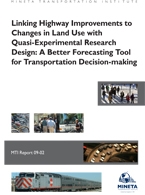- 408-924-7560
- mineta-institute@sjsu.edu
- Donate
Linking Highway Improvements to Changes in Land Use with Quasi-Experimental Research Design: A Better Forecasting Tool for Transportation Decision-making
An important issue for future improvement and extensions of highways will be the ability of projects to sustain challenges to Environmental Impact Statements based upon forecasts of regional growth. A legal precedent for such challenges was established in 1997 when a U.S. District Court judge ruled that the EIS for a proposed Illinois toll road was deficient because the growth projections were the same in the build and no-build scenarios. This paper incorporates popular regional growth forecasting models into a quasi-experimental research design that directly relates new highway investments in three California counties to changes in population and employment location, while controlling for no-build historical counterfactuals. The authors model simultaneous employment and population growth from 1980 to 2000 in Merced, Orange, and Santa Clara counties, three California counties that received substantive highway improvements during the mid-1990s. The strategy permits a comparison of the before-and-after tests for effects of investments on economic growth and land use in three regions that contrast how increased highway access affects development patterns: (1) for an urban center in Santa Clara County, (2) for an exurban region in Orange County, and (3) for a small town in Merced County.
We find that traditional forecast approaches, which lack explicit control selection, can lead to erroneous conclusions about an impact. Our integrated form of the lagged adjustment model confirms results from a conventional form of the model that includes all cross-sectional units as observations; in both forms of the model we estimate a statistically significant increase in employment development in the exurban region in Orange County where new toll roads were constructed. In the case of Santa Clara County, neither our quasi-experimental integrated approach nor the conventional lagged adjustment approach estimates a significant effect on population or employment growth that can be attributed to the new highways constructed in the urban center. For the small town environment in Merced County, the conventional simultaneous growth regressions produce a materially different estimate than the approach we develop and examine in this paper. Isolating effects to local spatial units where the intervention occurred and their no-build counterfactual produces estimates of a statistically significant decrease in employment growth in the small town near the newly constructed highway bypass.
|
RICHARD G. FUNDERBURG, PhD Dr. Funderburg is assistant professor of urban and regional planning at the University of Iowa. His research investigates an array of factors that attract economic activities to both developing and advantaged regions; it includes the identification and analysis of industry clusters and the estimation of impacts from public investments in transportation infrastructure, housing, and financial incentives on economic growth and patterns of development. He earned a PhD in Planning, Policy, and Design from University of California, Irvine and he holds M.P.P.A. and B.A. degrees from California State University. |
|
HILARY NIXON, PhD Dr. Nixon is an Assistant Professor of Urban and Regional Planning at San Jose State University. Her research and teaching interests in the field of environmental planning and policy focus on the relationship between environmental attitudes and behavior, particularly related to waste management, and linkages between transportation and the environment. She has a B.A. from the University of Rochester in Environmental Management and a PhD in Planning, Policy, and Design from the University of California at Irvine. |
|
MARLON G. BOARNET, PhD Marlon G. Boarnet is Professor of Planning, Policy, and Design and Economics at the University of California, Irvine, where he has been on faculty since 1991. From 2003 through 2006, Boarnet was Chair of the Department of Planning, Policy, and Design at UC Irvine. Boarnet earned a PhD from Princeton University in 1992. Boarnet´s research focuses on the inter- and intra-metropolitan distribution of economic activity, the links between transportation policy and economic development, local economic development policy, and land use . travel behavior interactions. Boarnet´s publications on these and other topics include over 40 refereed articles, book chapters, and reviewed reports. Boarnet is a co-author of Travel by Design: The Influence of Urban Form on Travel, a comprehensive study of the potential for linking land use and urban design to transportation policy published by Oxford University Press in 2001. Since 2002, Boarnet has served as managing Co-Editor of the Journal of Regional Science, a leading scholarly journal at the intersection of urban economics and quantitative geography. Boarnet is also an associate editor of the Journal of the American Planning Association, and he serves on the editorial boards of the Journal of Planning Literature and Papers in Regional Science. Boarnet has received grants from or conducted contract research for the U.S. Environmental Protection Agency, the U.S. and California Departments of Transportation, the Robert Wood Johnson Foundation, the World Bank, the Bay Area Economic Forum, and the Orange County Business Council, among others. |
-
Contact Us
San José State University One Washington Square, San Jose, CA 95192 Phone: 408-924-7560 Email: mineta-institute@sjsu.edu






